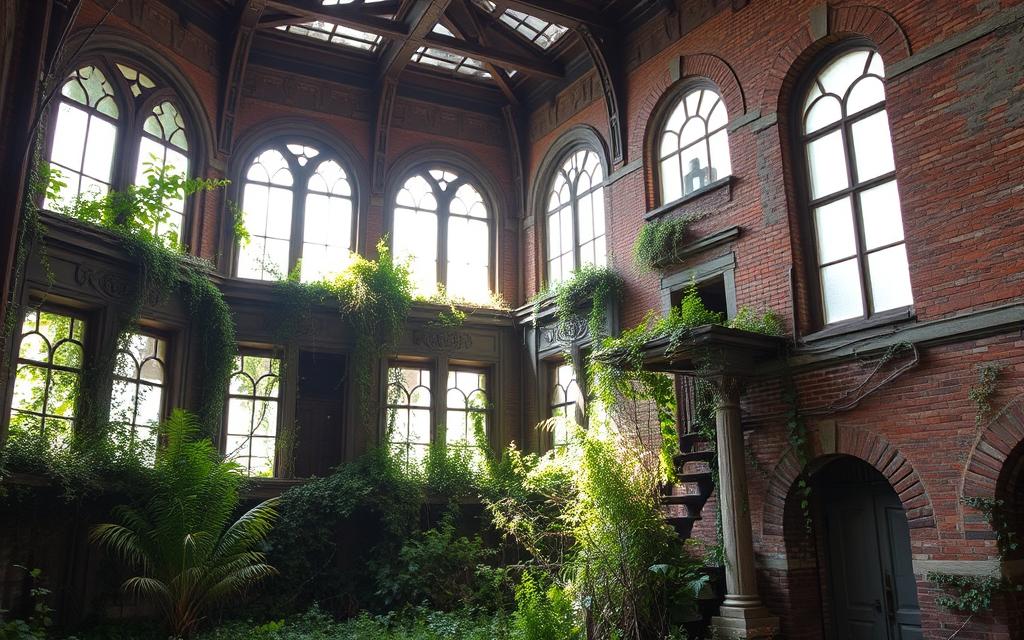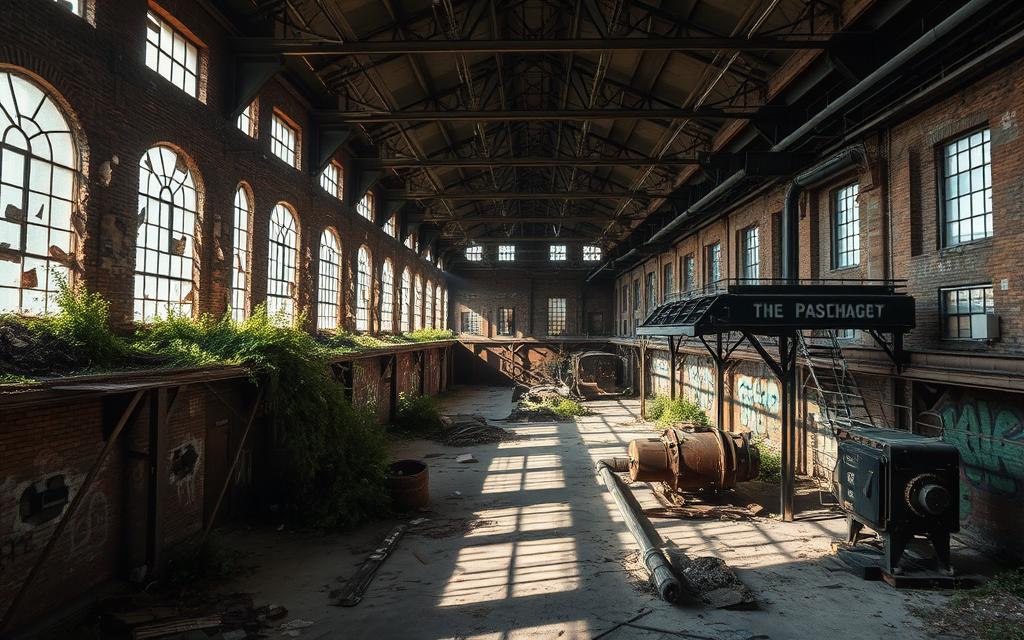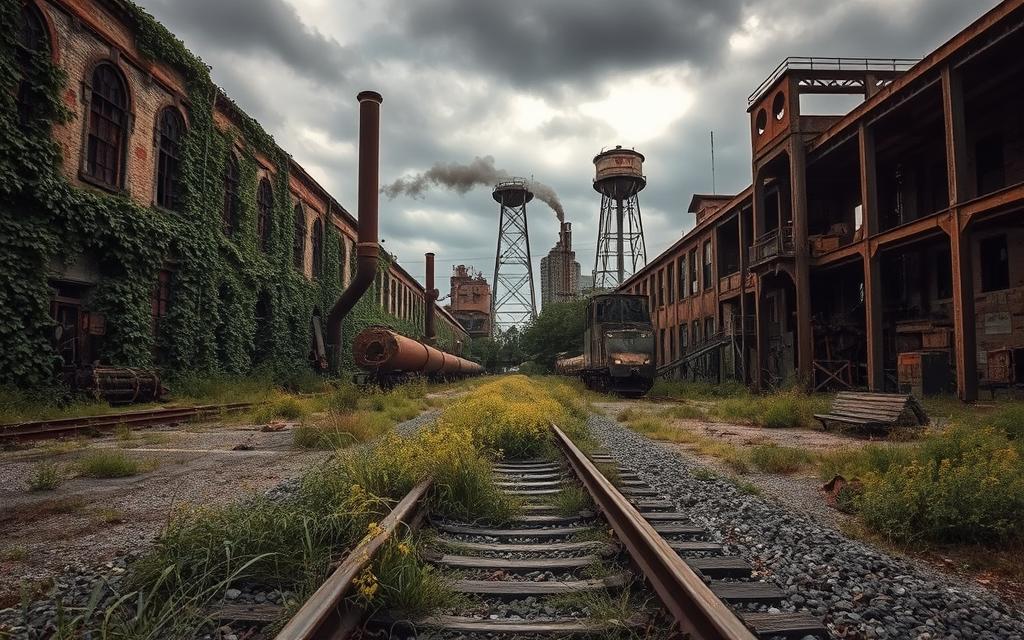Chicago is a city full of history. It has many abandoned places that attract explorers. These sites are more than just old buildings; they tell stories of the past.
From grand buildings to old factories, they show the city’s past glory. Each place has its own story, making Chicago a fascinating place to explore.
As you explore, you’ll find places with unique charm and mystery. These sites remind us of the city’s growth. They also spark the interest of those who love history and adventure.
Key Takeaways
- Chicago features a wide range of abandoned urban locations, each with its historical significance.
- Many historical sites, such as the Union Station Power House, are endangered and in need of preservation.
- Abandoned locations often provide unique opportunities for photography and urban exploration.
- Sites like the Alvin movie palace and the Old Chicago Post Office reflect the city’s cultural past.
- Exploration of these places reveals not just decay but also the chance for future use.
Discover Chicago’s Urban Exploration Scene
Urban exploration in Chicago gives you a peek into the past. It’s filled with abandoned structures that tell stories. Each building has its own tale, showing how time and culture have changed.
Why Urban Exploration Matters
Urban exploration uncovers history that’s often forgotten. Places like old hospitals and closed theaters show the beauty of decay. They make us appreciate their architecture and wonder about their past.
The Thrill of Finding Hidden Gems in Chicago
Exploring Chicago’s hidden spots is thrilling. You might find old warehouses or churches with fascinating stories. Each find sparks curiosity and connects you to the city’s history.
Breathtaking Abandoned Buildings in Chicago

Chicago’s abandoned buildings have a special charm. Each one tells a story that adds to the city’s history. Places like Ashmore Estates and the Joliet Correctional Center show how these sites once thrived. They give us a glimpse into the city’s architectural and social changes over time.
Historical Significance of Abandoned Structures
The Illinois Iron Furnace and the Cahokia Mounds State Historic Site are key examples. The Illinois Iron Furnace operated from 1839 to 1883, showing the industrial era’s peak. The Cahokia Mounds, from 900 to 1500 AD, highlight the area’s ancient culture. These sites connect us to Chicago’s past and show how the city has changed.
Photography Opportunities in Forgotten Places
Photographers find a unique canvas in Chicago’s abandoned places. The Damen Silos, standing tall from 1906, offer a dramatic setting. Their remains call for exploration and storytelling. Sites like the Uptown Theatre and St. Stephen’s Church also offer rich textures for photography, capturing Chicago’s visual history.
| Location | Historical Significance | Photography Highlights |
|---|---|---|
| Ashmore Estates | Asylum from 1959 to 1986 | Spooky interiors and haunting atmosphere |
| Joliet Correctional Center | Operated 1958 to 2002 | Imposing brick structures and ruins |
| Damen Silos | Built in 1906, abandoned after 1977 explosion | Vertical shots and textured walls |
| Cahokia Mounds | Pre-Columbian site, 900 – 1500 AD | Landscape photography and historic mounds |
The Best Abandoned Places to Explore in Chicago

Exploring Chicago’s abandoned spots is a journey into history and mystery. Each place has its own story to tell. As you explore, you’ll find adventure and learn about the city’s past.
Top Urban Exploration Locations
Here are some top spots for urban exploration:
- Damen Silos: Closed in the 1970s, these structures are now a canvas for graffiti and explorers.
- Cook County Hospital: Opened over a century ago, it closed in 2002, holding many stories.
- Lincoln Park Zoo: Once a home for animals, it’s now part of the city’s forgotten places.
- Uptown Theatre: Its grand design has been waiting for a revival for decades.
- Old Chicago Post Office: Once the city’s main post office, it now draws those who love history.
Unique Factors that Make These Places Stand Out
These sites are special because of their architecture, legends, and history. For example:
- Zion Evangelical Lutheran ‘Ghost Church’: Its garden contrasts with its past neglect, showing Pilsen’s history.
- Chicago Freight Tunnels: This underground network sparks curiosity about the city’s past.
- Meigs Field: Its remains tell of a dramatic change, including its destruction in 2003.
- St. Valentine’s Day Massacre Site: This site is famous for its dark history, drawing many.
- Biograph Theater Alley: Known for John Dillinger’s death, it has an eerie charm.
| Location | Year Abandoned | Notable Features |
|---|---|---|
| Damen Silos | 1970s | Graffiti art and height |
| Cook County Hospital | 2002 | Historical significance |
| Uptown Theatre | 1980s | Opulent architecture |
| Old Chicago Post Office | 1997 | Grand size and history |
| Meigs Field | 2003 | Remnants of airport infrastructure |
Visiting these spots in Chicago is more than an adventure. It’s a chance to connect with the city’s history. Each visit offers a glimpse into the past and helps us understand the city better.
Hidden Gems Chicago: Off the Beaten Path
If you’re looking to find Chicago’s hidden spots, you’re in for a treat. These places offer unique experiences that most tourists miss. They are perfect for those who love exploring local urban spots.
These spots let you discover Chicago’s history and culture. They are full of hidden treasures waiting to be found.
Local Favorites in the Abandonment Scene
The Old Chicago Post Office is a local favorite. It has become a symbol of urban reinvention. The Pullman Factory and Harvey Central School also offer deep dives into Chicago’s past.
These places are often missed by tourists. But they show the city’s rich history and culture. They are key to the urban exploration scene.
Decaying Beauty in Pilsen’s Ghost Church
Pilsen’s Ghost Church is a stunning sight. Built in the 1880s, it has survived fires and storms. Its story is as captivating as its weathered beauty.
This church is a must-see for those interested in Chicago’s forgotten places. It adds beauty to your urban exploration journey.
Urban Decay Chicago: The Allure of Ruins
Urban decay in Chicago opens a window into the city’s past. It shows how society and economy have changed. Exploring these ruins offers a unique look into Chicago’s history and its place in the world.
Understanding the History Behind Urban Decay
The history of abandonment in Chicago is tied to big changes in society and economy. Buildings that were once full of life now stand empty. They remind us of times when the city was booming and times when it wasn’t.
Walking through these areas, you see how things like gentrification and industrial decline have changed the city. Places like Saint Laurence Catholic Church show how much things have changed. They contrast the city’s past glory with its current state.
Exploring the Aesthetics of Abandoned Sites
The beauty of urban decay is undeniable. It’s a mix of imperfections and human stories. Places like the Joliet Correctional Center and South Side Masonic Temple show off their beauty despite being abandoned.
Photography can capture the contrast between beauty and decay. It helps us appreciate Chicago’s architecture. Urban decay in Chicago is like a canvas, where every broken wall tells a story of resilience and nostalgia.
| Site | History | Aesthetic Appeal |
|---|---|---|
| Saint Laurence Catholic Church | Built in 1911, abandoned in 2002 due to population shifts. | Gothic architecture with ornate details contrasting decay. |
| Joliet Correctional Center | Closed in 2002, a symbol of the state’s incarceration issues. | Imposing structure with a haunting allure amidst decay. |
| South Side Masonic Temple | Established in the early 1900s, now a canvas for urban explorers. | Exquisite craftsmanship showcased in a state of neglect. |
Conclusion
Exploring abandoned places in Chicago shows a rich story of the city’s past. Places like Cook County Hospital, closed in 2002, and the Uptown Theatre, abandoned in the 1980s, tell tales of the past. The Damen Silos, covered in graffiti, remind us of Chicago’s industrial past.
Looking into these old sites, we see the impact of urban decay. The Old Chicago Post Office, once a hub of activity, now stands quiet. It shows us a time that has passed. Exploring these places helps us appreciate their history and the lives connected to it.
Exploring abandoned places is a powerful reminder of change and strength. As we uncover the beauty and decay in these forgotten places, we help keep Chicago’s story alive. We make sure the memories of past communities live on.
FAQ
What are the best abandoned places to explore in Chicago?
The best places to explore in Chicago include the Damen Silos and the Historic Cook County Hospital. Also, the old Lincoln Park Zoo is a must-see. Each spot gives you a peek into the city’s past and its decay.
Why is urban exploration important in Chicago?
Exploring Chicago’s urban landscape is key to understanding its history. It lets you see the city’s transformation up close. By visiting these forgotten places, you connect with the city’s evolving story.
Are there any photography opportunities at abandoned sites in Chicago?
Yes! Abandoned sites like the Uptown Theatre and Damen Silos are perfect for photos. The light and shadows create stunning images that show the beauty of decay.
What makes Pilsen’s Ghost Church a notable abandoned site?
Pilsen’s Ghost Church is known for its eerie beauty and history. Built in the 1880s, it shows the area’s past. It’s a reminder of Pilsen’s cultural heritage.
How can I responsibly explore abandoned places in Chicago?
To explore responsibly, do your research first. Get permission if needed and follow safety rules. Respect the sites and avoid vandalism. This way, these places will be here for others to discover.
Are there specific urban decay locations that highlight Chicago’s history?
Yes, places like the Chicago Freight Tunnels and the old Pullman Factory are great examples. They show off unique architecture and tell stories of the city’s industrial and social changes.
What are some hidden gems in Chicago’s abandoned sites?
Hidden gems include the Old Chicago Post Office and Harvey Central School. These spots offer unique stories and connect you with the city’s lesser-known history.


